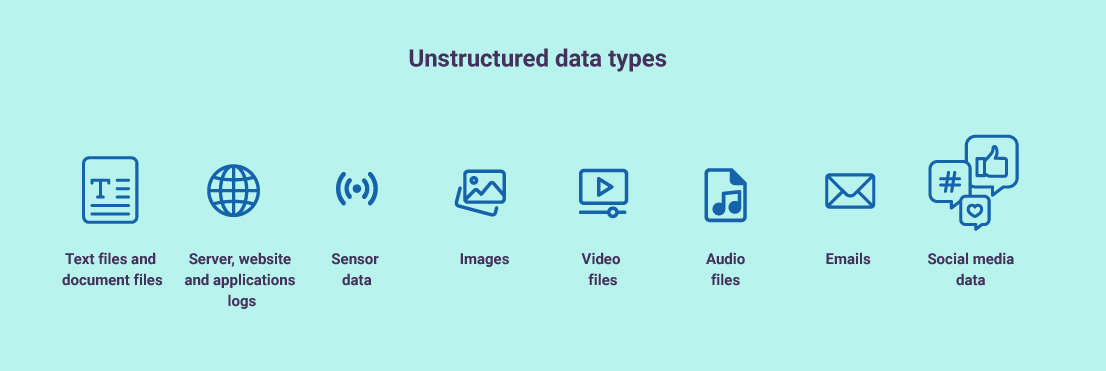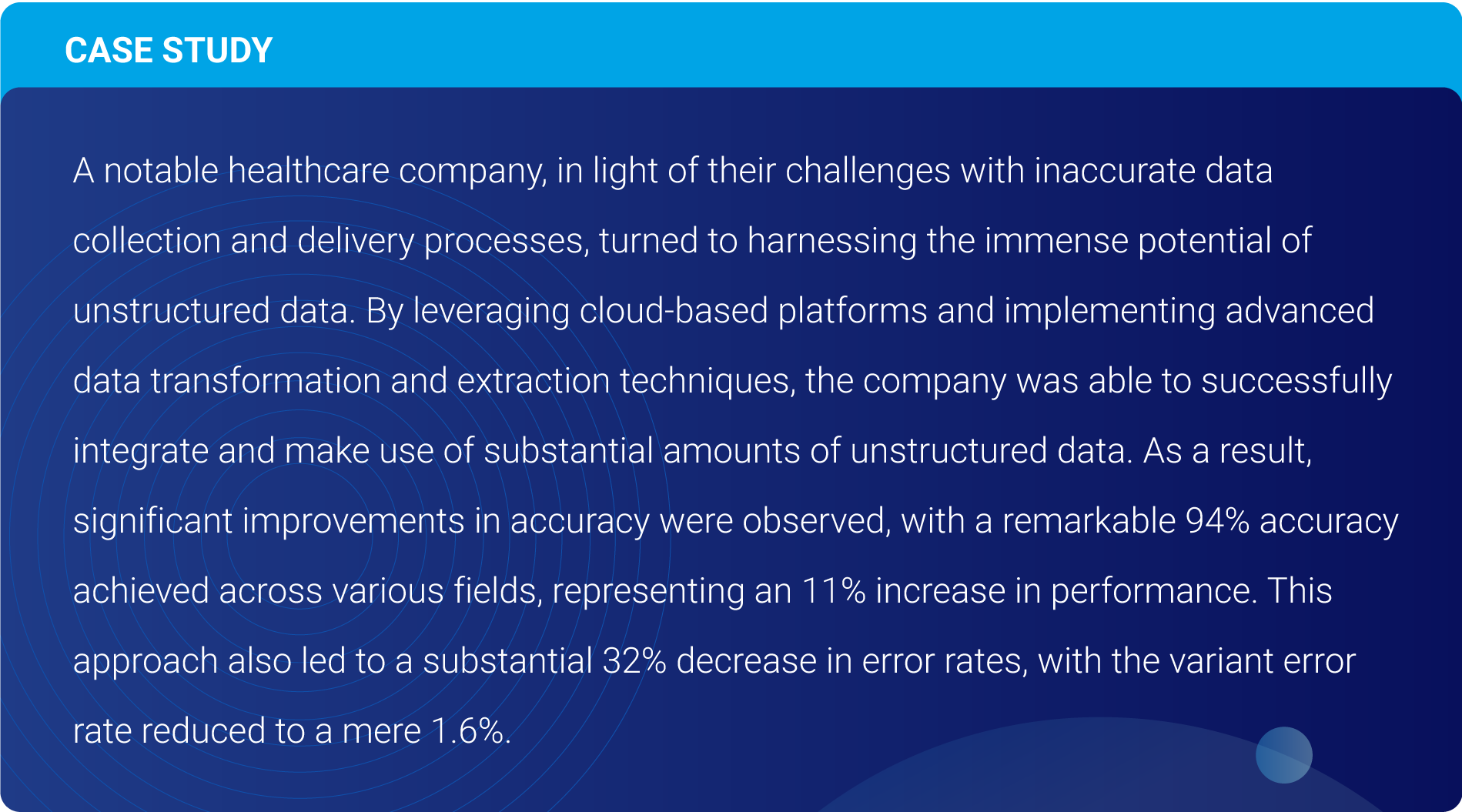The author is a Sr. Director - Data Engineer in Eucloid. For any queries, reach out to us at: contact@eucloid.com
The Emergence of Unstructured Data and Its Untapped Value for Businesses

Unstructured data is like the hidden treasure trove of the digital world. With a vast majority of the existing data lurking in the shadows, organizations are missing out on valuable insights and opportunities. Most data may be invisible to enterprises, but its impact is far-reaching and growing at an unprecedented rate.
To understand this, let’s get to the basics. What do you think of when you hear the word 'data'? Numbers, spreadsheets, and databases, graphs, and charts? But that is only the tip of the iceberg. Unstructured and semi-structured data make up a whopping 80-90% of all data, locked away in edge devices all around us. This is the visible data's invisible twin, often overlooked but bound to take over its structured counterpart in the coming years.
A recent report by IDC reveals that the collective sum of the world's data, also known as the datasphere, is set to grow from 33 zettabytes to a staggering 175 ZB by 2025. That's a compounded annual growth rate of 61%. These numbers may seem unfathomable, but they speak volumes about the untapped potential of data and its impact on various aspects of business.
.jpg)
So, what exactly is ‘unstructured’ data?
The very phrase may have people conjure images of chaotic information, scattered and unusable. But the truth is, it is a gold mine waiting to be tapped. And with its staggering growth rate of 55-65 percent each year, it's only getting bigger. Unstructured data consists of any information that doesn't neatly fit into a traditional database or spreadsheet. Until recently, it was dismissed as unimportant, too difficult to analyze and not worth the effort. But in the age of artificial intelligence, that mindset is changing.
Think of it this way - structured data is like a well-organized bookshelf, with every book placed neatly in its designated spot. Unstructured data, on the other hand, is like a cluttered and overflowing bookshelf, with books of various sizes and topics stacked haphazardly.

But just because it's messy doesn't mean it lacks value. In fact, we now have powerful tools specifically designed to access the insights hidden within unstructured data. And with these tools, a whole new world of possibilities has opened up. Social media giants like Meta are leading the way, utilizing deep learning technology to recognize our faces, analyze our social media posts, and even understand our sentiments and emotions behind those posts.
Information that falls under the unstructured data umbrella

Unstructured data across sectors
In certain industries, the amount of unstructured data being generated is growing at an exponential rate. For instance, the life sciences field is producing massive amounts of unstructured data through imaging techniques and genome sequencing. Similarly, healthcare professionals are relying more and more on digital methods for tasks such as viewing medical images and analyzing pathology reports.

Here’s how it looks like for other prominent sectors!
- Banking: From call logs and audio recordings to chatbot conversations and credit card transaction history, unstructured data is rapidly growing in the world of finance
- Retail: With the rise of e-commerce and online shopping, retailers are gathering large quantities of unstructured data from sources such as social media, product images, and online browsing history
- Insurance: The insurance industry is incorporating unstructured data in the form of customer feedback, claim reports, and risk assessment data to improve processes like fraud detection and risk assessment
- Oil & Gas: Seismic data analysis and compliance monitoring are important sources of unstructured data for organizations in this sector
- Transportation: The rise of autonomous vehicles means that transportation companies are accumulating a significant amount of unstructured data related to vehicle performance and safety
While many industries have been quick to capitalize on this opportunity, two have truly seized the potential of unstructured data — retail and finance. Back in the mid-2000s, retailers were the first to recognize the power of unstructured data and its potential for targeted marketing to specific customers. They utilized advanced data analysis techniques to combine and make sense of the vast amount of information at their disposal. This allowed them to deliver personalized promotions and recommendations to customers, leading to increased sales and customer satisfaction.
However, in recent years, the finance industry has matched the advancements made by retail. By analyzing unstructured data, banks can gain valuable insights into customer behavior, preferences, and patterns. This enables them to offer more tailored and personalized services. But it's not just retail and finance taking advantage of unstructured data. Various other industries, such as shipping, transportation, legal, and real estate, are now realizing the potential and are actively embracing unstructured data to stay ahead of the game.
Use-cases of unstructured data
Data that does not fit into traditional databases and spreadsheets can benefit businesses in the most unconventional ways. Be it sales, marketing, product development, or customer service, unstructured data can be harnessed to gain powerful insights and drive informed decisions.

Sales and marketing
- Identify customer purchasing patterns and sentiment
- Analyze social media posts, forum discussions, and other media
- Improve sales and marketing performance
Customer service
- Automate KYC process for new customers
- Verify and extract information from documents
- Streamline customer onboarding process
Human resources
- Scan and sort job applications
- Identify top candidates through keyword matching and analysis
- Streamline hiring process
Accounting and finance
- Automated data entry of receipts and invoices
- Categorize expenses and track profit/loss
- Generate financial reports and forecasts
Income tax return filing
- Automated system for collating income data from various sources
- Calculate taxable income and deductions
- Generate accurate tax returns for individuals and businesses
Healthcare
- Automated system for patient data entry and records management
- Extract insights from health reports and medical records
- Improve medical decision-making and patient care
Product development
- Understand customers' needs and preferences
- Extract insights through sentiment analysis of customer forums, calls to customer service, and social media
- Make informed decisions to enhance products/services
The untapped value of unstructured data
Unstructured data has often been overlooked and undervalued in the world of data analytics, but the truth is, it holds a wealth of valuable information that can greatly benefit businesses. By neglecting unstructured data, companies are missing out on vital insights into their brand's performance, the competitive landscape, market trends, and most importantly, customer sentiment.
Deeper analysis
What makes unstructured data so valuable is its ability to provide deeper and more detailed insights compared to structured data. While structured data can tell you the what, such as customer purchase patterns or web page usage, unstructured data reveals the why. It offers a comprehensive understanding of customers' thought processes, preferences, behaviors, and needs. With unstructured data, you can find answers to previously unknown questions, such as who your customers are, what your competitors are achieving, and why certain businesses are leading the industry.
Greater innovation opportunities
With better insights comes the opportunity for greater innovation. When armed with a complete understanding of your customers, their pain points, and preferences, your business can leverage this information to develop new and unique products or services. You can also identify and fill any potential market gaps to stay ahead of the competition.
More personalized customer experience
But perhaps the most significant impact of unstructured data is its ability to improve the customer experience. While structured data provides basic demographic information, unstructured data delves into the mindset of your customers. It brings a human element by allowing us to understand the emotions, opinions, and thoughts behind the numbers. It gives us a more complete picture, allowing us to make more informed decisions and create more effective strategies. By analyzing social media posts, comments, reviews, and customer support tickets, you can learn first-hand what customers expect from your business, helping you work towards surpassing those expectations.
.png)
The greatest value of data is not in what it shows us, but what it helps us discover. With the help of advanced tools and a strategic mindset, businesses can navigate through uncharted territories of unstructured data and unveil hidden insights and opportunities. Eucloid, with its vast experience and expertise, has successfully classified and processed over 30 terabytes of unstructured data piles, helping businesses make sense of this vast and unorganized landscape. To tap into the full potential of your unstructured data, contact Eucloid now.
Posted on : October 19, 2023
Category : Data Engineering
About the Authors

Selvakumar Krishnamoorthy
 LinkedIn
LinkedIn